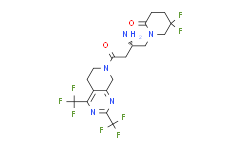| Cas No.: | 911637-19-9 |
| Chemical Name: | GeMigliptin |
| Synonyms: | GeMigliptin;1-[(2S)-2-amino-4-[2,4-bis(trifluoromethyl)-6,8-dihydro-5H-pyrido[3,4-d]pyrimidin-7-yl]-4-oxobutyl]-5,5-difluoropiperidin-2-one;Gemigliptin Hydrochloride;Gemigliptin Tartarate |
| SMILES: | N[C@H](CN1C(=O)CCC(F)(F)C1)CC(N1CCC2C(C(F)(F)F)=NC(=NC=2C1)C(F)(F)F)=O |
| Formula: | C18H19F8N5O2 |
| M.Wt: | 489.362991571426 |
| Purity: | >98% |
| Sotrage: | 2 years -20°C Powder, 2 weeks 4°C in DMSO, 6 months -80°C in DMSO |
| Description: | Gemigliptin is a highly selective dipeptidyl peptidase 4 (DPP4) inhibitor with a KD of 7.25 nM. |
| Target: | Ki: 7.25 nM (DPP4)[1] |
| In Vivo: | Administration of gemigliptin supressed elevated serum levels of advanced glycation end products (AGE) in type 2 diabetic db/db mice. In mice and dogs, gemigliptin prevents the degradation of active glucagon-like peptide-1 by DPP-4 inhibition, which improves glucose tolerance by increasing insulin secretion and reducing glucagon secretion during an oral glucose tolerance test[2]. |
| In Vitro: | In in vitro assay, gemigliptin dose-dependently inhibits methylglyoxal-modified AGE-bovine serum albumin (BSA) formation (IC50=11.69 mM). AGE-collagen cross-linking assays shows that gemigliptin has a potent inhibitory effect (IC50=1.39 mM) on AGE-BSA cross-links to rat tail tendon collagen. In addition, gemigliptin directly traps methylglyoxal in a concentration-dependent manner[1]. Gemigliptin is a reversible and competitive inhibitor with a Ki value of 7.25±0.67 nM. Gemigliptin shows at least >23,000-fold selectivity for DPP-4 over various proteases and peptidases, including DPP-8, DPP-9, and fibroblast activation protein (FAP)-α[2]. |
| Kinase Assay: | The enzyme kinetic analysis of gemigliptin on DPP-4 is performed using a continuous spectrophotometric assay with the substrate Gly-Pro-pNA. Briefly, inhibition of DPP-4 activity is determined by measuring the absorbance (at 390 nm) resulting from the cleavage of the substrate Gly-Pro-pNA by the DPP-4 enzyme under steady-state conditions. Enzyme activity is defined as the slope (in mOD/ min) from 5 to 15 min. The inhibition pattern is evaluated using a Lineweaver-Burk plot, and the Ki is determined using a curve- fitting program[2]. |
| Animal Administration: | Mice[1] Seven week-old male C57BL/KsJ-db/db mice and their lean littermates (db/þ, normal) are randomly assigned to three (n=10) groups. One group of db/db mice is orally administered gemigliptin (100 mg/kg body weight) and another group is administered the same amount of vehicle via oral gavage for 12 weeks. Non-diabetic littermates receive the same vehicle treatment. Blood glucose level and body weight are measured weekly[1]. |
| References: | [1]. Jung E, et al. Gemigliptin, a novel dipeptidyl peptidase-4 inhibitor, exhibits potent anti-glycation properties in vitro and in vivo. Eur J Pharmacol. 2014 Dec 5;744:98-102. [2]. Kim SH, et al. Pharmacological profiles of gemigliptin (LC15-0444), a novel dipeptidyl peptidase-4 inhibitor, in vitro and in vivo. Eur J Pharmacol. 2016 Oct 5;788:54-64. |

 To enhance service speed and avoid tariff delays, we've opened a US warehouse. All US orders ship directly from our US facility.
To enhance service speed and avoid tariff delays, we've opened a US warehouse. All US orders ship directly from our US facility.




















